As the debate over health care reform rages on and insurance
premiums climb precipitously higher, the state of modern medicine is in
critical condition. More and more people are falling ill, while increasingly fewer
have access to the pricey, patented drugs that purport to cure them.
The situation looks dire–that is, unless you ask author, professor, and
intrepid botanical explorer Chris Kilham. The solution to our health care woes,
he insists, is growing all around us: plant medicines. Having traveled to over
20 countries seeking out the most remarkable remedies nature has to offer,
Kilham works to bring the powerful healing effects of these little-known
plants to the rest of the world.
I recently chatted with Chris Kilham about medicine hunting,
Amazonian shamanism, and his upcoming appearance at Evolver Atlanta’s
EvolverFest 2010.
RS: You go by the
title Chris Kilham, “Medicine Hunter.” What does this mean exactly?
Chris Kilham: Well,
I investigate plant medicines–you know, they can be roots, flowers, seeds, nut
oils, whatever they might be–in different native places around the world. So
you know, India, China, South and Central America. I’ve been doing a lot of
work in the Amazon over the past dozen years or so.
I investigate plants that in almost all cases I already know
about. So I go to the Amazon to investigate, let’s say, cat’s claw. You know,
cat’s claw is out there, there’s a lot of information on it. But I may want to
help to get this plant greater recognition, broader use, broader trade. So I’ll
go to these native places and spend time with anybody and everybody who’s
involved with the plant. And that inevitably leads to participating in rituals
and ceremonies and activities that might be different from what we’re doing
back here in the U.S. And then when I come back here, I help to establish trade
between companies and native entities so they can get an economic benefit from
the trade in these plants–and do it in a way that’s ethical and environmentally
sustainable.
And then to add to that I spend a lot of time on television
these days–on Fox, on other news channels–promoting plant medicine to the
world. Letting people know about these things so they understand that these are
real, these things work. These aren’t secondary or alternative–these are the
most rock-solid, guaranteed beneficial pharmacy we’ve got. So that’s kind of
what I do.
And there’s a big
challenge then in convincing people of the efficacy of plant medicines over
standard pharmaceuticals?
Well, yeah, I mean, we are the single most drug-crazed
culture in the entire world. Our pharmaceutical use is, I think, five times
that of other developed countries. We’re insane about drugs. And so as a
result, we’re heavily marketed to, the entire health system is biased toward
promoting and dispensing these drugs, and most of the health system mechanisms
are basically drug delivery mechanisms. So it’s deeply entrenched in our
culture. And yet plant medicine is the number one most popular medicine in use
today on planet Earth. So sometimes people really appreciate getting that
perspective: “Oh, this is the number
one category of medicine in the world.” There are lots of reasons for it.
You have a quote on your website that says, “85% of the people in the world rely primarily on herbs
as medicines.” Here in the U.S. typically when we get sick we visit a doctor,
get prescribed medicines and treated in that way. How does this work in other
parts of the world that primarily use herbs to treat illness?
Well, it depends on the place in the world, you know? If
it’s Germany you might walk into a pharmacy and buy your herbal products there.
Your herbal cold remedies may be on the shelf of pharmacies – and only pharmacies. Or you may live in the
Amazon and you go to the local herbalist who pulls a bunch of different plants,
boils them in a pot, and makes you drink them and hang out there for a couple
of days, and get well and then go.
You know, the methods of dispensing these plant drugs and
the cultures vary immensely. In rural China, it’s all teapot medicine. In
Morocco, it’s vendors in the public squares with hundreds of trays of different
herbs and seeds and oils and other types of naturally derived agents. You go to
them and tell them what your health need is and they make stuff up for you, you
know? So it ranges from products that have gone through this whole scientific
process, and plants that have not which may be every bit as effective.
I think of this woman I’ve gone to see three times now in
Malaysia. She’s an herbalist, and she takes all of these herbs in their crudest
dry form and makes these products. She has this really large clientele of
people who come to her for them exactly because they work. So it’s all over the
place in terms of how people put these things out.
So, how did this all
start for you, then? How did you first get interested in studying plant
medicines?
Well I always think it’s sufficient to say I was a hippie in
the ‘60s. That should explain everything! [Laughs.] You know we kind of like all
woke up one day and said, “Natural is better, we all have to learn to cook
brown rice, let’s start doing yoga, let’s meditate, let’s find out about plant
drugs and consume all of them.”
And I think through that I became exposed to people who
would come to me and say, “Hey man, have you ever tried Ginseng?” I’d be like,
“Ginseng, I’ve heard of that.” So I would read up on things. There was far less
information then than there is now. And eventually, oh gosh, I think when I was
around 19 or so, I wound up on an herb walk with a then kind of famous
herbalist, this guy named Ben Charles Harris. And at the end of that, after
basically walking through the exact same kind of flora that I’d grown up around
my entire life, walking behind this guy and have him talking about the
medicinal properties of basically every plant was pretty amazing to me.
And from that point on through study I developed a college
curriculum. I made up my own major–basically it was holistic health–and I did a
lot of herbal study. It just grew from there reading hundreds of books, and you
know, traveling all over the world investigating these things with the
scientists and doctors and herbalists. It’s just been this growing body of
knowledge and interest.
You do a lot of work
to promote maca. I’d never heard of
this before. It’s a Peruvian plant, right?
Yeah, well, maca is a root that looks like a turnip. It only
grows at very high altitude–over ten and a half, eleven thousand feet, but most
abundantly at fourteen to fifteen thousand feet. So, way up in the Andes. And
it has unusual energy enhancing, stamina promoting, and overall sexual and
reproductive health enhancing properties.
It’s a big, big deal. So, I’ve been involved with maca for about 13
years. These days my primary client is a French company called Naturex. You
know, I need to have somebody pay for all my field research. It’s not free to
bop around the world. And so they’re very much involved in the maca trade. I’m
the person who goes back and forth between the source up there and the company.
So in that capacity, I’ve worked to promote maca. Because
this is wonderful stuff. It’s got what they like to call the triple bottom
line. If you eat maca, if you take a maca product that’s legitimate, you’re
gonna feel this overall enhancement. It’s unquestionably this
“make-you-feel-very-very-good” superfood. And the cultivation that we’re
involved in is certified organic, so there’s this environmental benefit. You
know, nothing bad is happening to the people in the fields as a result of
growing this stuff. And furthermore, we pay more than other people do in the
area so there’s benefit sharing with the native maca growers. So, it’s a sweet
thing to be involved in. I’ve brought a lot of reporters and groups up there
over time. We did this with CNN most recently.
So, when you promote
these things, and let’s say they take off, what are the best ways to safeguard
and protect the indigenous culture and environment once these global markets
really get going?
Well, it depends where they are. The folks in the Andes have
a little bit of an advantage in that that region still remains among the least
developed. But in general, all of these native cultures are changing and will
change. And so the big question for them is will they be economic underclass
people, or will they have some sort of better advantage?
Sure, some sort of
leverage.
Right, are they gonna wind up chambermaids and busboys and
taxi drivers, or could they have their own thing? And so with this trade, you
know, there’s no jewel of a sound bite that kind of wraps it all up. This is a
constantly changing dynamic. You’ve got people and their lives and traditions
and all of these different influences. And yeah, actually, the truth is they’d
be thrilled to have flush toilets. That’s the truth. I mean, they don’t
necessarily like crapping through a board into the mud–it’s what they’ve got.
So some of the things that really distinguish truly native villages from what
we’re used to–a lot of it, not all of it–has to do with a complete, utter lack
of amenities.
I mean, these people’s lives are gonna change, so if they
can gain some economic benefit, which is what they say they want, I don’t ever
impose or say “you need this.” I never say those words. But then the trade in
medicinal plants, if it’s done right, you know, environmentally sustainably–and
that has all kinds of meanings whether you’re cultivating or wild
harvesting–it’s worth helping to make this happen and increase demand so that
these people do have a market opportunity. And we get great medicine.
I came across an
article you wrote about drinking ayahuasca in the Amazon. Was it just that one
time, or have you had multiple experiences with it?
No, I’ve done ayahuasca about two dozen times. And the most
recent time was outside of Pucallpa, actually, a couple months ago. One of the
shamans who trouped through [the ayahuasca lodge] Espiritu de Anaconda was this
nice guy, Mariano. It took some time to track him down in Pucallpa where he was
from, but my friend and I went and did ceremony with him. He was very
wonderful. I think it’s a rather remarkable opportunity that we have to do this
in that area, in that setting. And I think that there are a number of good
talented people who are doing this.
You work with shamans
from all over the world. I think that shamanism can be kind of an enigmatic,
mysterious term to a lot of people. How would you describe what a shaman is and
what they do?
Well, I think specifically what the shaman does is shuttle
back and forth with relative ease between the phenomenal and spirit worlds. So,
somebody who has more flexibility in terms of the dimensions that they can have
an experience in. Typically the shaman is a healer, often shamans know plants.
Every tradition produces people who certainly genuinely qualify to be called
shamans by virtue of their skills or some types of ceremonies they conduct. And
I think that people who are good shamans–who have an integrated sense of body,
mind, and spirit and of how we move through this sort of waking dream–I think
that these people bring a valuable, mind-opening, spirit-releasing sort of
sensibility to the world.
Many of them are very hands on with psychoactive plants, but
many are purely ritual shamans who don’t use any psychoactive plants at all and
still can guide people through remarkable experiences. Some are unusual and
talented diagnosticians–you know, they can look at you and just start to tell
you stuff about yourself. “Wow, you’ve had stomach problems since you were like
four. But your brother didn’t.” You know? Things like that, where you go, “yeah
right.”
The shaman who–certainly not the first one I met and spent
time with, but the shaman who really did it for me, who set me off on a
continuing path of inquiry about this group of people–was a 103-year-old woman
Maria Cina. She was known in this particular region on the Amazon in Brazil as
“the shaman’s shaman.” Like, when the shamans needed healing, or when they all
got together on rare occasion, it was to see Maria Cina. She was this little
tiny lady who still did her own housework, you know? [Laughs.]
That’s wild!
Yeah, so she said things to me. She didn’t know me, she
couldn’t have heard about me. They had no communications. But she said, “You
bridge the world. You tell people about each other. This is important for you
to do.” She was not only describing what I was involved in, but I felt at that
moment she was giving me a very specific directive. And she said, “I’m going to
do a little ceremony, just relax.”
I had no idea what she was doing. And she
just patted my head and my face, neck and shoulders, my back and chest very
gently with her hands while she muttered this chant. Then she did the same
thing for this friend of mine who is a shaman for another tribe in Brazil, and
with whom I was living at the time in the forest. And after she was done with
us–and she hadn’t made any suggestion about what was to take place or
anything–we both started to feel like we were cooking from the inside out. And
we got so hot we repeatedly threw ourselves in the river all day long. It
didn’t make any difference–
Wow, so this
continued long after the ceremony?
–oh, yeah, yeah, yeah! She did this little thing on us for a
few minutes each. Then we just cooked like pigs over a spit until about three
o’clock the next morning, at which point this raging furnace inside just
abruptly went–boomph—done! We both passed out and woke up
feeling like heroes. Just like, “Oh my god, I feel so cleansed, refreshed,
empowered, invigorated, clear…”
We both remarked on it. There really was no suggestion, I
thought she was just doing some sort of a little blessing on us, and she turned
out to be this energy monster. So I think that, at the very least, shamans are
non-conformists, you know? They’re occupying some outlying, extremely valuable
territory that we need to know and embrace.
For sure. That’s the
huge paradigm battle though, you know? It goes way beyond plant medicine versus
pharmaceuticals.
Oh yeah! I mean, there are lots of different arenas where
this is playing out. There are people healing old wounds taking ayahuasca on
the Nauta road. There are people making fortunes selling purified plant
molecules to Chanel, you know? [Laughs.] Everything is happening out there. And
the challenge is, can you ride all these currents and move some of these trends
along, and also enjoy repeated dips into that wellspring of shamanic energy and
knowledge.
Well said. You
are going to be here in Atlanta in June hosting a workshop and giving the
keynote talk at EvolverFest. What can people expect at these events?
Well, I think people can expect to have a genuine, sincere,
enjoyable and maybe even surprising journey into the world of plant medicines
and into shamanic culture. I think I can deliver on that promise well. Some of
the things they’ll experience I think I’ll save for that time. But you know, my
job is really to do exactly what Maria Cina said, to bridge the world. And to
take people there, visually, with stories and with explanations in the time
that we have.
That sounds
excellent. We’re super excited for your visit here, Chris. Thanks for talking
with me.
Sure thing, you take care until then!
Chris Kilham will be the keynote speaker at EvolverFest 2010 in Atlanta on Sunday, June 20th. He will also be hosting an intimate workshop called "The Shaman's Pharmacy" the previous day, June 19th, at the Hearth Atlanta. For more details and early registration, visit www.evolverfest.com.













